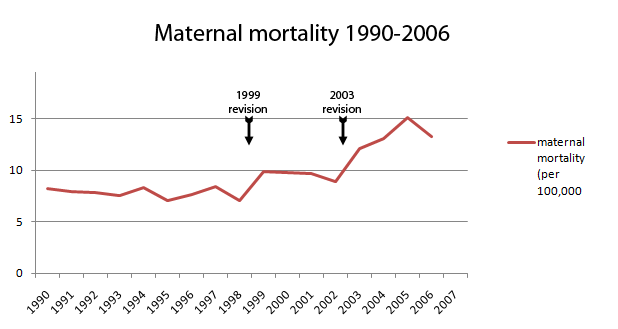Today’s post on Science and Sensibility is an object lesson in everything that is wrong with contemporary natural childbirth advocacy.
The post is entitled The Importance of Understanding and Reversing Disparities in Maternal Health Outcomes, and it proports to be a good faith examination of the high maternal mortality rate among women of color in the US.
How does it illustrate what is wrong with contemporary natural childbirth advocacy? Let me count the ways.
1. It is a cynical exploitation of the issue of maternal mortality.
Following the lead of NCB Cynicist-in-Chief Ina May Gaskin, it raises the issue, not out of genuine concern for women of color, but merely to portray modern obstetrics as a system “in crisis.” Ina May Shows how its done:
Cynically ignore the real crisis in the care of women around the world who die for lack of access to modern obstetric care, and pretend that the “crisis” is that there aren’t more midwives to care for well white women in first world countries. Cynically ignore the fact that the leading causes of maternal mortality in the US are complications of pregnancy and pre-existing medical conditions like heart disease and kidney disease. Midwives can have no impact on these deaths because they don’t care for these patients.
Ina May represents herself as shocked at the current rate of maternal mortality, going so far as to create (and publicize) a memorial quilt. Yet as far as far as I can tell, Gaskin has done NOTHING (no research, no education, no fund raising) to reduce the incidence of maternal mortality. In contrast, modern obstetrics has lowered the maternal mortality rate 99% PERCENT in the past century.
2. Lying by omission is a favorite tactic of NCB advocates. Even so, the disingenuousness of these piece is astounding. Watch how it works in practice.
Write:
The CDC paper compares women of different races, ethnicities and nativity (US or foreign-born) from 1993-2006. They found that for all women, “the pregnancy-related mortality ratio (PRMR) increased significantly (P
But don’t mention:
In 1999 and again in 2003, the US Standard Certificate of Death was revised to ask explicitly whether any female death was associated with pregnancy, instead of relying on the person filling out the form to voluntarily provide that information and the definition of maternal death was expanded.
The results of these changes are captured by the following graph.
Write:
African American women have a three to four-fold greater chance of dying as a result of pregnancy than women in any other racial-ethnic group.
But don’t mention:
The disparity between women of African descent and women of other races occurs in all first world countries, among all practitioners including midwives.
Write:
… [E]xperts today commonly state that reasons for this disparity are “not fully understood,” and “limited data exist” to explain why they continue to occur.
But don’t mention:
The lack of understanding is not from lack of trying to understand. This is one of the most intensive areas of public health and obstetric research.
3. Play the one note samba.
Like a piece of music with only one note, natural childbirth advocates have only one response to every situation: question the use of “interventions.”
At this point, it’s like a Monty Python sketch:
Man: “My wife died in childbirth.”
NCB Advocate: “Did she have an episiotomy”
Man: “She died of cardiac complications?”
NCB Advocate: “How unfortunate. Did she have an episiotomy?”
Man: “She had a history of congenital heart disease that led ultimately to her death.”
NCB Advocate: “Bummer. Did she have an episiotomy?”
The authors of the Science and Sensibility piece does not bother to mention that the contemporary causes of maternal mortality are changing. At this point, maternal cardiac disease is one of the leading causes of maternal death. Cardiac disease includes peripartum cardiomyopathy, and underlying cardiac conditions, particularly congenital cardiac anomalies. These women die because of lack of access to advanced medical technology, not because of medical technology.
Yet NCB advocates are still banging away on the same note:
… [P]ublic health paradigms have more often focused on antecedents to care (access to contraception and prenatal care) and outcomes (mostly newborn and infant health) with less attention to the processes of care or interventions during the birth itself.
Those interventions being:
… five major interventions used in the birth process: induction, electronic fetal monitoring, epidurals, episiotomy, and cesarean section.
Is there any scientific evidence that these interventions have any impact on maternal mortality? The author references a book chapter Contemporary Childbirth in the United States: Interventions and Disparities. I just read that chapter. In 43 dense pages of texts and charts, its authors provide NO evidence that the use of interventions in childbirth is related to maternal mortality in any way. No evidence, none, zip, zero, nada.
No problem. That was never the point of the post. The point of the post was to suggest a maternity system “in crisis,” to deliberately misrepresent the problem, and to provide yet another opportunity to bang away at the one note samba. Mission accomplished!
When faced with a high rate of maternal mortality among African Americans, the question that NCB advocates want to know is: did she have an episiotomy? If asking that question in the face of horrible tragedy is not cynical, I don’t know what is.



